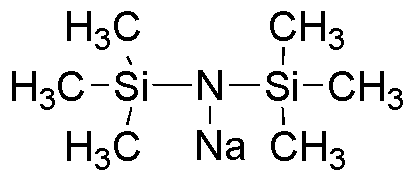Sodium bis(trimethylsilyl)amide solution, 1.0 M in THF is widely utilized in research focused on:
- Organic Synthesis: This compound serves as a strong base and nucleophile, making it ideal for deprotonation reactions and the synthesis of various organic compounds, particularly in the creation of complex molecules in pharmaceuticals.
- Metalation Reactions: It is commonly used in metalation processes, where it helps in the introduction of metal centers into organic frameworks, enhancing the catalytic properties of compounds in materials science.
- Silicon Chemistry: The compound plays a crucial role in silicon-based chemistry, facilitating the formation of silanes and siloxanes, which are important in the production of silicone materials used in sealants and adhesives.
- Polymer Chemistry: It is utilized in the synthesis of novel polymers, particularly those that require specific functional groups, enabling the development of advanced materials with tailored properties for applications in coatings and electronics.
- Research in Catalysis: This solution is a key reagent in the development of new catalytic systems, providing researchers with the ability to explore innovative pathways for chemical transformations, thus improving efficiency and selectivity in reactions.
General Information
Properties
Safety and Regulations
Applications
Sodium bis(trimethylsilyl)amide solution, 1.0 M in THF is widely utilized in research focused on:
- Organic Synthesis: This compound serves as a strong base and nucleophile, making it ideal for deprotonation reactions and the synthesis of various organic compounds, particularly in the creation of complex molecules in pharmaceuticals.
- Metalation Reactions: It is commonly used in metalation processes, where it helps in the introduction of metal centers into organic frameworks, enhancing the catalytic properties of compounds in materials science.
- Silicon Chemistry: The compound plays a crucial role in silicon-based chemistry, facilitating the formation of silanes and siloxanes, which are important in the production of silicone materials used in sealants and adhesives.
- Polymer Chemistry: It is utilized in the synthesis of novel polymers, particularly those that require specific functional groups, enabling the development of advanced materials with tailored properties for applications in coatings and electronics.
- Research in Catalysis: This solution is a key reagent in the development of new catalytic systems, providing researchers with the ability to explore innovative pathways for chemical transformations, thus improving efficiency and selectivity in reactions.
Documents
Safety Data Sheets (SDS)
The SDS provides comprehensive safety information on handling, storage, and disposal of the product.
Product Specification (PS)
The PS provides a comprehensive breakdown of the product’s properties, including chemical composition, physical state, purity, and storage requirements. It also details acceptable quality ranges and the product's intended applications.
Certificates of Analysis (COA)
Search for Certificates of Analysis (COA) by entering the products Lot Number. Lot and Batch Numbers can be found on a product’s label following the words ‘Lot’ or ‘Batch’.
*Catalog Number
*Lot Number
Certificates Of Origin (COO)
This COO confirms the country where the product was manufactured, and also details the materials and components used in it and whether it is derived from natural, synthetic, or other specific sources. This certificate may be required for customs, trade, and regulatory compliance.
*Catalog Number
*Lot Number
Safety Data Sheets (SDS)
The SDS provides comprehensive safety information on handling, storage, and disposal of the product.
DownloadProduct Specification (PS)
The PS provides a comprehensive breakdown of the product’s properties, including chemical composition, physical state, purity, and storage requirements. It also details acceptable quality ranges and the product's intended applications.
DownloadCertificates of Analysis (COA)
Search for Certificates of Analysis (COA) by entering the products Lot Number. Lot and Batch Numbers can be found on a product’s label following the words ‘Lot’ or ‘Batch’.
*Catalog Number
*Lot Number
Certificates Of Origin (COO)
This COO confirms the country where the product was manufactured, and also details the materials and components used in it and whether it is derived from natural, synthetic, or other specific sources. This certificate may be required for customs, trade, and regulatory compliance.

